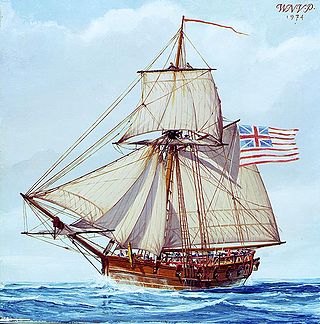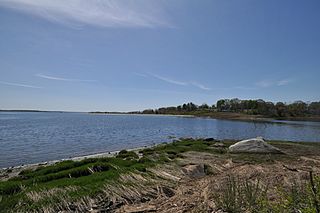Related Research Articles

Narragansett Bay is a bay and estuary on the north side of Rhode Island Sound covering 147 square miles (380 km2), 120.5 square miles (312 km2) of which is in Rhode Island. The bay forms New England's largest estuary, which functions as an expansive natural harbor and includes a small archipelago. Small parts of the bay extend into Massachusetts.

Commander Abraham Whipple was an American naval officer best known for his service in the Continental Navy during the Revolutionary War and being one of the founders of Marietta, Ohio. Born near Providence, Colony of Rhode Island, Whipple chose to be a seafarer early in his life and embarked on a career in the lucrative trade with the West Indies, working for Moses and John Brown. In the French and Indian War period, he became a privateersman and commanded privateer Game Cock from 1759 to 1760. In one six-month cruise, he captured 23 French ships.
Ten ships of the Royal Navy have carried the name HMS Spitfire, while an eleventh was planned but renamed before entering service. All are named after the euphemistic translation of Cacafuego, a Spanish treasure galleon captured by Sir Francis Drake.

USS Providence was a sloop-of-war in the Continental Navy, originally chartered by the Rhode Island General Assembly as Katy. The ship took part in a number of campaigns during the first half of the American Revolutionary War before being destroyed by her own crew in 1779 to prevent her falling into the hands of the British after the failed Penobscot Expedition.

The Gaspee affair was a significant event in the lead-up to the American Revolution. HMS Gaspee was a Royal Navy customs schooner that enforced the Navigation Acts around Newport, Rhode Island, in 1772. It ran aground in shallow water while chasing the packet boat Hannah on June 9 off of Warwick, Rhode Island. A group of men led by Abraham Whipple and John Brown I attacked, boarded, and burned the Gaspee to the waterline.
Ten ships of the Royal Navy have been named HMS Royalist:
HMS Sultana was a small Royal Navy schooner that patrolled the American coast from 1768 through 1772. Her role was to prevent smuggling and to collect customs duties. She was retired and sold in 1773 when unrest in Britain's American colonies required larger, better armed patrol craft.

Pawtuxet Village is a section of the New England cities of Warwick and Cranston, Rhode Island, United States. It is located at the point where the Pawtuxet River flows into the Providence River and Narragansett Bay.
USS Roebuck was a barque used by the Union Navy during the American Civil War.
Seven ships of the Royal Navy have borne the name HMS Penguin. A penguin is a flightless aquatic bird.

Gaspee Point is a small peninsula on the west side of the southern reaches of the Providence River in Warwick, Rhode Island. It is bounded on the north by Passeonkquis Cove and on the south by Occupessatuxet Cove, and is accessible by Namquid Drive in Warwick.
USS Bartlett may refer to the following ships operated by the United States Navy:
USS W. F. Bartlett was a schooner acquired by the United States Navy in 1861.
Five vessels of the Royal Navy have been named HMS Harlequin.
Darius Sessions was a deputy governor of the Colony of Rhode Island and Providence Plantations during the buildup to the American Revolutionary War. He was heavily involved in moderating the effects of the Gaspee Affair, and was instrumental in keeping the perpetrators from being identified.

The historiography of the Gaspee affair examines the changing views of historians and scholars with regard to the burning of HMS Gaspee, a British customs schooner that ran aground while patrolling coastal waters near Newport, Rhode Island and was boarded and destroyed by colonists during the lead up to the American Revolution in 1772. Scholars agree that the incident sparked a period of renewed tension between Great Britain and its American colonies, but they disagree as to the specific long- and short-term impacts of the attack on British and colonial policies and attitudes.

HMS Kingfisher was the second ship in the 14-gun Swan class of ship sloops, to which design 25 vessels were built in the 1760s and 1770s. She was launched on 13 July 1770 at Chatham Dockyard, and completed there on 21 November 1770. She took part in the American Revolutionary War, enforcing the blockade of the Delaware Bay, and served in the Battle of Turtle Gut Inlet, near Cape May, New Jersey. While under the temporary command of Lieutenant Hugh Christian, she was burnt by her own crew to avoid capture on 7 August 1778 in Narragansett Bay during the Battle of Rhode Island.
John Cole (1715—1777) was a lawyer who became the 12th Chief Justice of the Rhode Island Supreme Court, serving from 1764 to 1765. Following his short tenure as Chief Justice, he became a Providence legislator, and Speaker of the Rhode Island House of Deputies. In this role he was on a committee to draft instructions to Providence citizens in regards to protesting the egregious Stamp Act passed by the British parliament to tax the American colonists. During the lead up to the American Revolutionary War Cole was privy to the plan and execution of the burning of the British revenue schooner Gaspee that ran aground near Pawtuxet, Rhode Island. He was deeply complicit with Stephen Hopkins and other leading Providence citizens in withholding evidence from the British commission of inquiry that was established to find the instigators of the Gaspee Affair. After a year of collecting testimonies, the court dissolved, having failed to indict a single person. In 1775 Cole became the Advocate General of Rhode Island's Vice Admiralty Court, but died of smallpox just two years later.

John Carter was an early American printer, newspaper publisher, and postmaster of Providence, Rhode Island. Carter entered the printing profession as an apprentice of Benjamin Franklin while living in Philadelphia. After he entered into a partnership and ran The Providence Gazette, which he eventually purchased and ran on his own up until the year of his death.
HMS Gaspée was purchased in North America in 1772, commissioned in 1773, and captured in 1775. The Royal Navy recaptured her in 1776. She was recommissioned and served again until prepared for disposal at the end of 1777. At some point she was at the "Battle of Fundy", but when this occurred and what her role was is currently obscure.
References
- Bartlett, John Russell (1861). A History of the Destruction of His Britannic Majesty's Schooner Gaspee, in Narragansett Bay, on the 10th June, 1772. A. C. Greene, printer to the state.
- Colledge, J. J.; Warlow, Ben (2006) [1969]. Ships of the Royal Navy: The Complete Record of all Fighting Ships of the Royal Navy (Rev. ed.). London: Chatham Publishing. ISBN 978-1-86176-281-8.